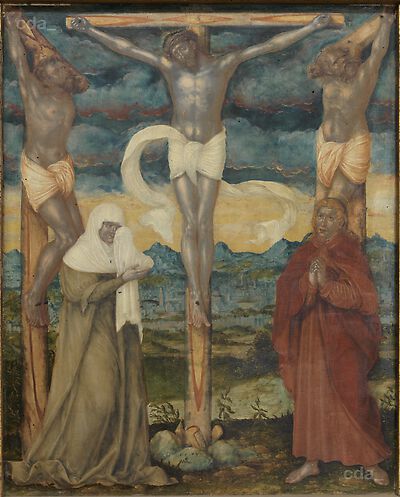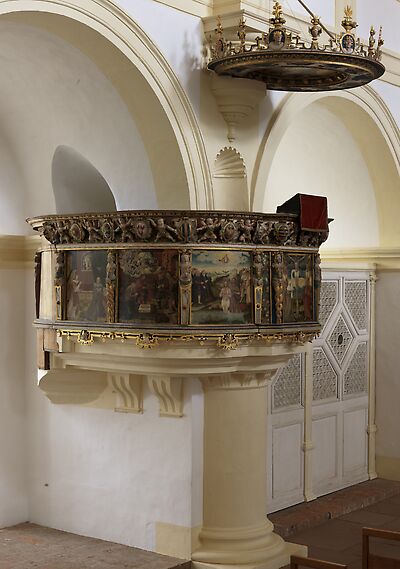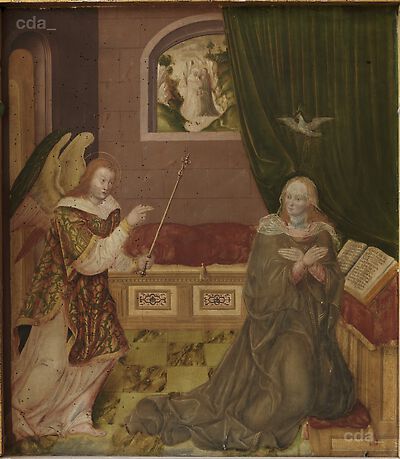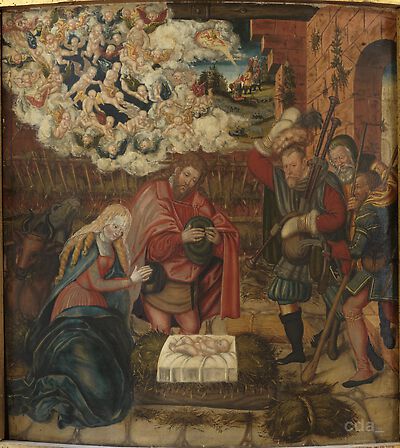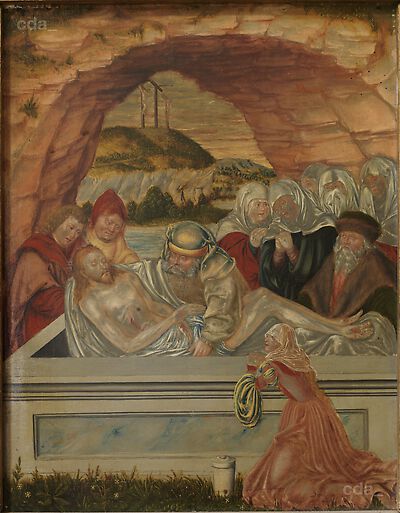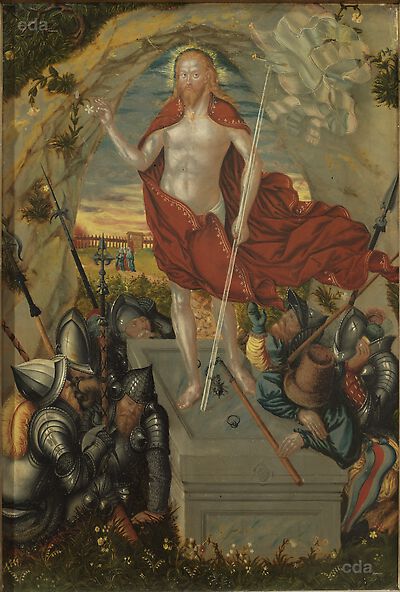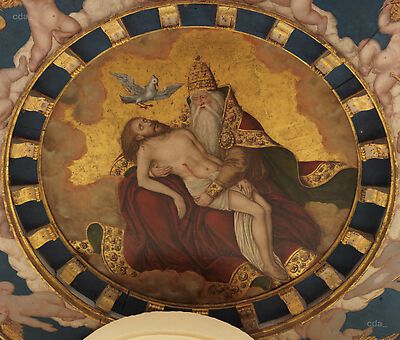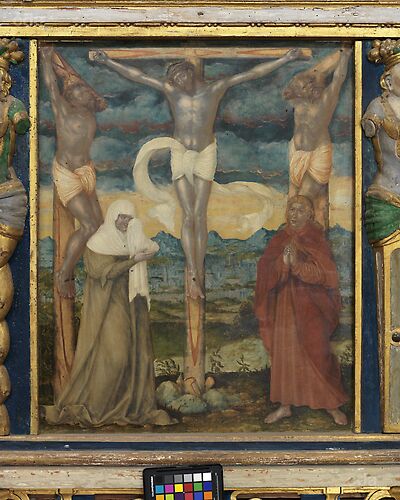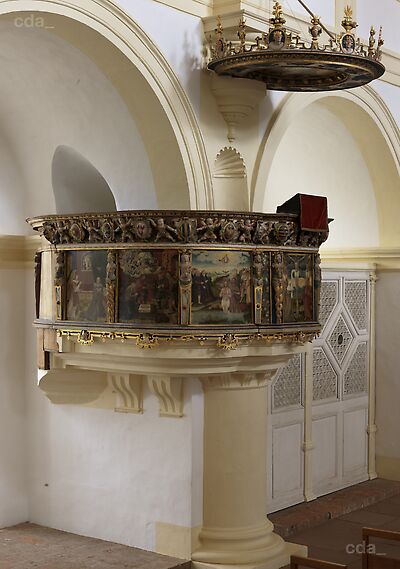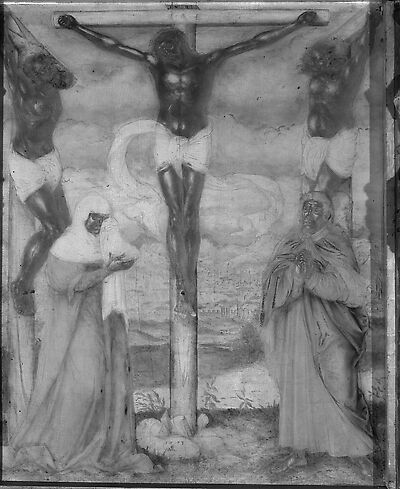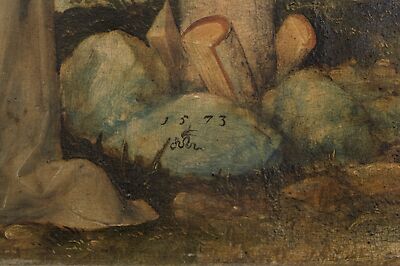Support
The panels are mounted in the pulpit and due to the coniferous wood paneling are not accessible from the reverse, therefore any assessment of the support remains conditional. In the few areas where bare wood is visible it is pale in appearance.
The examination report from 1990 of the conservation of the abat-voix states that its panel painting was executed on lime wood. The support of the altarpiece created by Cranach the Younger for the castle chapel was also lime wood. It may therefore be assumed that the pulpit paintings were also painted on lime wood.
When viewed in raking light a slight unevenness of the surface suggests that the panel consists of four planks.
[Herrschaft 2013, 35, 37]
Ground and Imprimatura
A thin glue-chalk ground was applied with a brush to the sized support. On the right and left edges of the panel the ground extends to the edge of the support. The upper edge of the panel appears to have a continuous barb, which is visible on the left half of the panel. It may be assumed that the panel was fixed in plane along at the top and bottom edges by a grooved batten while the ground was applied. There is a thin lead white imprimatura covering the ground.
[Herrschaft 2013, 39]
Underdrawing
The underdrawing on the pulpit paintings was executed on the imprimatura. The lines were carried out in a dry drawing material, possibly a grey/black chalk. Like the Baptism scene here the execution of the underdrawing is very sketchy and spirited. The contours of the figures were described with delicate, sometimes repeated lines, which are binding to a certain degree. The indicated arrangement of the folds serves again only as a rough orientation. Executed in straight, angled and curved as well as wiggly lines the design was first corrected and clarified during the painting process. However, one alteration within the composition did occur at the underdrawing stage. The figure of St John was initially one centimeter further to the right and was then shifted and redrawn.
In contrast to the Baptism scene the background of the Crucifixion was not indicated with a few fleeting lines. Instead the townscape exhibits some binding lines for columns, walls and windows, that were carried out with short strokes. These may have been transferred from a pre-existing design and/or carried out by another person.
[Herrschaft 2013, 41]
Paint Layers and Gilding
The paint layers probably consist of pigments bound in oil (a test for protein proved negative). On all the panels the paint layers extend to the edge at the sides - like the ground - whereas the paint layers at the top and bottom end before the ground.
By and large all the panels exhibit a very economic painting technique with a thin application of paint, which nevertheless is predominantly opaque. In addition there are areas of glazed colour, where the imprimatura is occasionally visible and influences the colour scheme of the panel.
The quality of the painting is very mixed and reveals the cooperation of more than one person on each panel. Many of the affectionately executed details are only visible close up, which considering the position of the panels 2 meters above is never possible. Other areas are less precise and occasionally unfinished (this is also the case for the decorative painting on the pulpit).
Areas of the flesh paint are less subtly nuanced than in the Nativity and Baptism scenes. The faces of the Virgin and St John were painted in a darker grey over an initial brown layer and the subsequent flesh tone was more thickly applied. The hands of St John and Jesus were executed in a similar manner. In contrast the feet of Jesus are much softer and more accurately painted with more extensive use of flesh tones. Even the individual veins have been modulated.
St John's red robe was executed with a very thin application of paint allowing the ground to shimmer through and the brushstrokes are also visible. The paint is an admixture of vermilion and ochre, with an increased addition of white for the lighter folds. His coat is bright red and may again contain vermilion. Shadows and folds were executed employing a dark glaze.
The Virgin's robe was, like in the annunciation scene, executed in paint containing smalt over a grey paint layer. The upper section of the sky is roughly executed in dark blue paint, which was applied more thinly for the clouds so that the ground shimmers through and the brushstrokes are visible. The paint was appplied criss-cross in short strokes. Azurite was employed as the blue pigment, over which (in part) a layer containing smalt was applied. After the application of the blue paint layers the lower edge of the central layer of clouds was finished with rough brushstrokes in red paint. Finally the volume of the clouds was defined employing delicate lines of white, yellow and pink along their underside. The section of the sky above the horizon was painted yellow. Within this zone areas were left in reserve and the imprimatura was covered with a thin grey glaze to indicate clouds. Some yellow lines give the clouds their shape.
[Herrschaft 2013, 56-58]
- written by Jana Herrschaft
